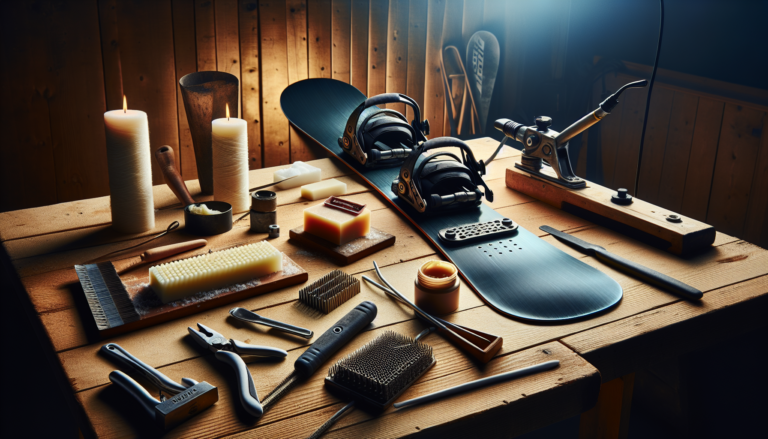Snowboarding is an exhilarating winter sport that requires proper gear maintenance for optimal performance and longevity. One of the most crucial aspects of snowboard maintenance is waxing, which helps your board glide smoothly over the snow and protects its base from wear and tear. If you’re new to snowboarding or want to learn how to wax your board at home, this step-by-step guide will walk you through the process.
Why Waxing Your Snowboard is Important
Benefits of Waxing Your Snowboard
Waxing your snowboard offers several key benefits that enhance your riding experience and extend the life of your board:
- Smoother ride: A properly waxed snowboard glides effortlessly over the snow, reducing friction and allowing for a smoother, more enjoyable ride.
- Faster performance: Wax helps your board move faster, enabling you to maintain speed on flat sections and carry momentum through turns.
- Board longevity: Regular waxing protects your snowboard’s base from drying out, cracking, and absorbing moisture, ultimately prolonging its lifespan.
How Often Should You Wax Your Snowboard?
The frequency of waxing your snowboard depends on several factors, such as riding conditions, board type, and personal preference. As a general rule of thumb:
- Wax your board every three to five rides, or whenever you notice a decrease in performance.
- Apply a fresh coat of wax at the beginning and end of each season to keep your board in top condition during storage.
- Consider more frequent waxing if you ride in icy, dry, or man-made snow conditions, as these can quickly strip away the existing wax.
Tools and Materials Needed for Waxing a Snowboard
Essential Tools for Waxing
To wax your snowboard at home, you’ll need the following tools and materials:
| Tool | Purpose |
|---|---|
| Wax | The main material applied to the snowboard base for protection and performance |
| Iron | A specialized tool used to melt and apply the wax evenly across the base |
| Scraper | A plastic tool used to remove excess wax after application |
| Structuring brush | A brush used to texture the base after waxing for optimal performance |
| Cloth | A clean, lint-free cloth for wiping down the base before and after waxing |
Choosing the Right Wax
Snowboard waxes come in various formulas designed for specific temperature ranges and snow conditions. The two main types are:
- Temperature-specific wax: These waxes are formulated for specific temperature ranges, such as warm (0°C to -4°C), mid (-4°C to -12°C), or cold (-12°C and below). Choose the appropriate wax based on the expected conditions at your riding location.
- All-temperature wax: As the name suggests, this type of wax is designed to perform well in a wide range of temperatures and is a good choice if you’re unsure about the conditions or want a versatile option.
Step-by-Step Guide to Waxing Your Snowboard
Step 1: Clean the Edges
Before waxing, ensure your snowboard’s edges are clean and rust-free. Use a file guide and file to remove any burrs or rust spots gently, and then wipe down the edges with a clean cloth. This will help the wax adhere better and prevent contamination.
Step 2: Clean the Base
Next, clean your snowboard’s base to remove any dirt, debris, or old wax. This step is crucial for ensuring proper wax absorption. Use a citrus-based base cleaner and a clean cloth to wipe down the base thoroughly. Allow the base to dry completely before proceeding.
Step 3: Apply the Wax
Using a wax-specific iron, heat the wax until it melts and drips onto the snowboard base. Hold the iron just above the base and move it in a circular motion, allowing the melted wax to drip evenly across the entire surface. Be careful not to let the iron touch the base directly, as this can cause damage.
Step 4: Spread the Wax Evenly
Once you’ve applied a sufficient amount of wax, use the iron to spread it evenly across the base. Keep the iron moving constantly to avoid overheating any area. The goal is to create a thin, uniform layer of wax covering the entire base. Allow the wax to cool and harden for about 30 minutes.
Step 5: Scrape Off Excess Wax
Using a plastic scraper, remove the excess wax from the snowboard base. Hold the scraper at a 45-degree angle and apply firm, even pressure as you scrape from nose to tail. Use long, continuous strokes to ensure a smooth finish. Repeat this process until you’ve removed most of the visible wax.
Step 6: Buff and Brush the Base
To give your snowboard a polished finish and expose the base structure for optimal performance, use a scouring pad or structuring brush to buff the base lightly. This will remove any remaining wax residue and create a smooth, glossy surface. Brush from nose to tail, following the direction of the base structure.
Tips and Tricks for Effective Snowboard Waxing
Ensuring Proper Ventilation
Always wax your snowboard in a well-ventilated area, as the fumes from melting wax can be harmful if inhaled in large quantities. Open windows, use a fan, or work outdoors if possible to maintain a safe waxing environment.
Maintaining the Right Iron Temperature
To avoid damaging your snowboard base, ensure your waxing iron is set to the correct temperature for the type of wax you’re using. Most waxes have a recommended temperature range printed on the packaging. A temperature between 120°C and 140°C is generally safe for all types of wax.
Using a Sharp Scraper
A sharp scraper is essential for removing excess wax effectively and achieving a smooth finish. Replace your scraper if it becomes dull or damaged, as a blunt scraper can lead to an uneven base and poor performance on the snow.
Recycling Wax Scrapings
Don’t let your wax scrapings go to waste! Collect them in a jar or container and melt them down to create a recycled wax blend. This eco-friendly practice saves money and reduces waste. Just be sure to strain out any dirt or debris before reusing the wax.
By following these steps and tips, you’ll be able to wax your snowboard like a pro, ensuring a smooth, fast ride and prolonging the life of your board. Regular waxing is an essential part of snowboard maintenance, so make it a habit and enjoy the benefits on the slopes!






